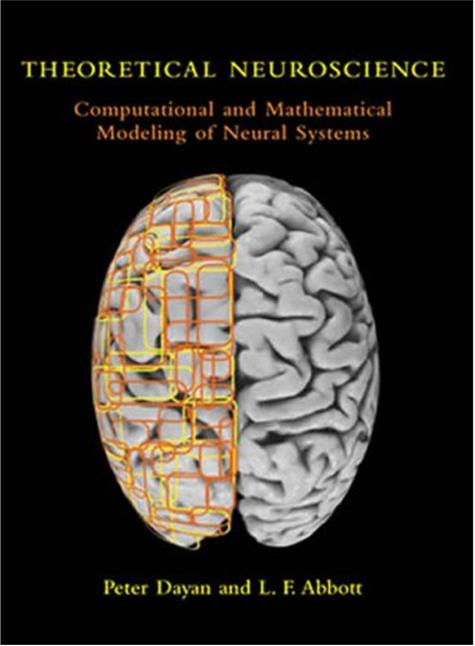Brief description of the course
-
Syllabus (PDF)
-
Course slides (only available to the ones subscribing the course)
-
Final report (PDF)
-
Reading materials
1. Koch, C. (2004). The Quest for Consciousness: A Neurobiological Approach. (Englewood, CO: Roberts and Co,)

What are the biophysical and neurophysiological operations that give rise to specific conscious perceptions? How can the brain, a physical system, express subjective states such as emotions? How can neural activity give rise to sensations like pain? What is consciousness? Koch presents the best scientific answers to these questions. (A review of this book) (PDF in chinese available)
2. P. Dayan and L. F. Abbott. Theoretical Neuroscience: Computational and Mathematical Modeling of Neural Systems, The MIT Press, 2001

Theoretical neuroscience provides a quantitative basis for describing what nervous systems do, determining how they function, and uncovering the general principles by which they operate. This text introduces the basic mathematical and computational methods of theoretical neuroscience and presents applications in a variety of areas including vision, sensory-motor integration, development, learning, and memory. (PDF)
3. Sanchez J C, Principe J C. Brain-machine interface engineering. Morgan & Claypool Publishers, 2007.
Neural interfaces are one of the most exciting emerging technologies to impact bioengineering and neuroscience because they enable an alternate communication channel linking directly the nervous system with man-made devices. This book reveals the essential engineering principles and signal processing tools for deriving control commands from bioelectric signals in large ensembles of neurons. The topics featured include analysis techniques for determining neural representation, modeling in motor systems, computing with neural spikes, and hardware implementation of neural interfaces. Beginning with an exploration of the historical developments that have led to the decoding of information from neural interfaces, this book compares the theory and performance of new neural engineering approaches for BMIs. (Tutorial: BMI Signal Processing)
4. Cover T M, Thomas J A. Elements of information theory 2nd edition. 2006. (PDF)
5. Barto A G. Reinforcement learning: An introduction. MIT press, 1998. (PDF)
6. Luck S J. An introduction to the event-related potential technique. MIT press, 2014.
7. Sanei S, Chambers J A. EEG signal processing. John Wiley & Sons, 2008.
8. Fuster J A M. Cortex and mind: Unifying cognition. Oxford university press, 2003.
9. Churchland P S, Sejnowski T J. The computational brain. The MIT press, 1992.
10. Haykin S. Cognitive dynamic systems: Perception-Action cycle, radar and radio. Cambridge University Press, 2012.
11. Pulvermüller F. The neuroscience of language: on brain circuits of words and serial order. Cambridge University Press, 2002.
12. Hawkins J, Blakeslee S. On intelligence. Macmillan, 2007.
13. Baars B J, Gage N M. Cognition, brain, and consciousness: Introduction to cognitive neuroscience. Academic Press, 2010.
14. Johnson-Laird P N. Mental models: Towards a cognitive science of language, inference, and consciousness. Harv. Uni. Press, 1983.
15. A reading list on Bayesian methods (http://cocosci.berkeley.edu/tom/bayes.html).
16. Cognitive Modeling Greatest Hits (http://cseweb.ucsd.edu/~gary/CogSciLiterature.html)
17. CCS-Lab Computational Cognitive Science Lectures (http://health.adelaide.edu.au/psychology/ccs/docs/ccs-class/previous.html)
18. 计算认知科学实验室小组 (http://www.douban.com/group/391831/)
19. Ten classics from cognitive science (http://cognitrn.psych.indiana.edu/rgoldsto/cogsci/classics.html):
20. Hinton, Geoffrey E. "Learning multiple layers of representation." Trends in cognitive sciences 11.10 (2007): 428-434.(PDF)
21. Tenenbaum, Joshua B., Thomas L. Griffiths, and Charles Kemp. "Theory-based Bayesian models of inductive learning and reasoning." Trends in cognitive sciences 10.7 (2006): 309-318.(PDF)
22. Griffiths, Thomas L., and Joshua B. Tenenbaum. "Optimal predictions in everyday cognition." Psychological Science 17.9 (2006): 767-773.(PDF)
23. Cognitive Science Society (http://cognitivesciencesociety.org/index.html)
24. Reading list from Yale's Perception & Cognition Lab (PDF)

 (创新港)
(创新港)


